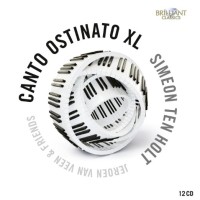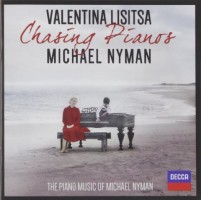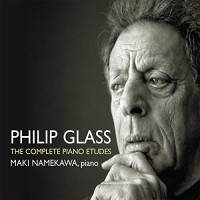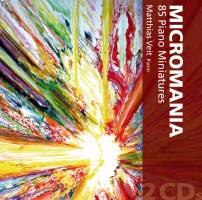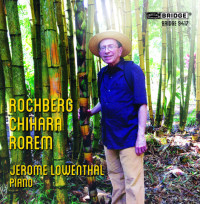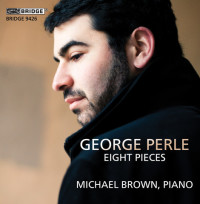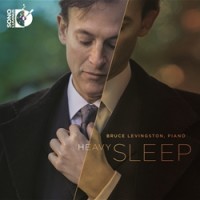Piano Factory 15: Micro and Macro
|
Grant Chu Covell [June 2015.]
“Canto Ostinato XL.” Simeon ten HOLT: Nine versions of Canto Ostinato (1976-79). Jeroen van Veen, Sandra van Veen (pnos, prepared pianos, synthesizers), Irene Russo, Fred Oldenburg, Marcel Bergmann (pnos), Aart Bergwerff (org), Esther Doornink, Peter Elbertse (marimbas). Brilliant Classics 9453 (12 CDs) (http://www.brilliantclassics.com/). Someone really likes Canto Ostinato, an extended minimalist jolt of variable length and forces. Here are nine renditions of ten Holt’s most famous opus, recorded in various places between 1999 and 2014. All performances exceed an hour, and three require two discs. Built from multi-measure cells which can be repeated ad lib, this may be the longest work constructed on an unbroken stream of quintuplets. It is also a potent dose of B-flat minor. The chord changes and emerging melodies suggest a mid-60s folksong (I heard echoes of ¡El pueblo unido jamás será vencido! which Rzewski used in The People United Will Never Be Defeated!), and mild ethnic flavorings, similar to the Spanish touches that infuse Scarlatti’s sonatas. I hear a bit of Schubert in the two oases where a melody floats over a falling bass-line sequence. The composer specifies keyboard instruments. The work may not be arranged for other forces. Two pianos (79:11) offer a most sensible realization with the smoothest transitions. The other eight versions expose subtleties beyond traditional non-sustaining keyboards. At 149:54, the grand four-piano version does not assault as much as expected, and very infrequently, but delightfully, the pianos will momentarily not synchronize. The piano(s) and marimba(s) combinations offer the driest ensembles, whereas the prepared piano pass (69:52) and the concluding two-disc synthesizer version (145:34) permit sustained effects and textures which are immensely welcome when all 12 discs are charted in sequence. The solo organ version (62:50) did not entertain, despite the instrument’s varied stops and registers. You will find yourself muttering 1-2-3-4-5 even after a superficial exposure to Canto Ostinato. Perhaps the work charms because of the constantly varying five-note patterns (2+2+1, 3+2, etc.). Like Ravel who eventually disdained Bolero, apparently ten Holt became annoyed by the attention focused on Canto. Van Veen and friends have spread the love across other ten Holt pieces, including another giant, the three-piano two-plus hour Incantatie IV (1987-90, Brilliant Classics 94918, 58:01 + 65:52) which doesn’t captivate. As if acknowledging the inevitable, the van Veen clan followed Canto Ostinato XL with Canto Ostinato XXL, a four-disc, four-piano-plus-organ version (Brilliant Classics 94990). Nine versions of Simeon ten Holt’s Canto Ostinato (1976-79)
“Chasing Pianos.” Michael NYMAN: Asst. piano works. Valentina Lisitsa (pno). Decca B0020135-02 (1 CD) (http://www.universalmusicclassics.com/). Philip GLASS: The Complete Piano Etudes (1994-2013). Maki Namekawa (pno). Orange Mountain Music OMM 0098 (2 CDs) (http://www.orangemountainmusic.com/). Lisitsa and Namekawa herald a new generation of performers who are comfortable ignoring the composers’ own renditions. Glass’ etudes started life as a way for him to improve his own technique and express his vocabulary. The first series asks for precision, if not consistency and evenness. The second series is much more relaxed and confident, with clever references to other historical styles. Namekawa is not as rigid as the composer himself; indeed, there’s a surprising Rachmaninoff flashiness to the whole endeavor. Exploring 25 solo tracks taken from various scores, including The Piano, Drowning by Numbers, The Diary of Anne Frank, A Zed & Two Noughts, Man with a Movie Camera, Gattaca, etc., Lisitsa has no problem ignoring Nyman’s precedents, sensibly employing expressive rubato. We hear this immediately with the opening The Heart Asks Pleasure First from The Piano. My favorite track is the Mozart-inspired waltz, Sheep ’n’ Tides from Drowning by Numbers whose lilting tempo becomes surprisingly elastic. Lisitsa is not worried about misinterpreting Purcell in Chasing Sheep is Best Left to Shepherds (The Draughtsman’s Contract) preferring to follow the line and melody where it goes. Many numbers I had not known, or had made little impression before.
“Micromania.” Var comps: Var pieces. Matthias Veit (pno). Chromart Classics TXA12009 (2 CDs) (http://www.chromart-classics.de/). 85 piano miniatures, starting with Nielsen and concluding with Rossini, selected and organized in a clever and continuously revealing program (53:48 + 44:38). Veit may organize by key or match incipient and following harmonies. Consequently, some pieces intentionally segue: Scarlatti flows into Haydn, Couperin into Kuhnau, Busoni into Chausson. The Casella is a Chopin homage and Veit obliges with the obvious succession. Veit’s sly humor is everywhere. The ever-familiar Mussorgsky Promenade startles when it appears, acknowledging a stroll between the unfamiliar, sometimes blurring pieces. Apart from the Purcell, Mussorgsky, Beethoven, Brahms, Schumann, Schubert and Chopin, it would be a gigantic challenge to recognize all 85. This sampling covers great ground. Yes, I wished for Feldman and Lachenmann, but the Ives choice, Bad Resolutions and Good WAN, makes up for it. The Ligeti entry is the notorious single-note Bagatelle. And while we’re considering bagatelles, Beethoven is represented with Op. 119, No. 10, perhaps the shortest piece he ever wrote, although, ironically, I have heard others fly through it faster. Schoenberg’s Op. 19, No. 6, written after Mahler’s funeral, passes in a flash. The second disc is slightly more serious if only because of fugues by Poglietti, Wagner-Régeny, Hindemith and Reicha.
George ROCHBERG: Carnival Music (1971); Nach Bach (1966); Partita – Variations (1976). Paul CHIHARA: Bagatelles (2010). Ned ROREM: 75 Notes for Jerry (2007). Jerome Lowenthal (pno). Bridge Records 9417 (1 CD) (http://www.bridgerecords.com/). How does one explain Rochberg’s post-serial music without detours? Some composers try to forge new paths and attempt to escape history, others rediscover history and take big nourishing gulps. After a personal tragedy, Rochberg sought a vocabulary which would give him solace, and revisited music which was important to him, most of it from prior generations. These piano pieces reflect Rochberg’s comfort with this return, what we now call post-modernism or neo-Romanticism. Carnival Music elegantly slides between granitic dissonance, Stravinsky, Bach and so much else. Nach Bach’s borrowings are on clear display alongside Chopin detours. The Partita Variations further demonstrate the composer’s philosophy, thematic relationships widening as each variation appropriates different styles. Chihara’s internment in a WWII camp for Japanese Americans is alluded to in the Bagatelles, subtitled Twice Seven Haiku for Piano which draw upon Japanese folk tunes. Chihara will comfortably blend other music into his own as passing quotation and reflection. For an encore, Lowenthal provides the 83-second piece which Rorem wrote for his birthday.
George PERLE: Classic Suite (1938); Six Celebratory Inventions (1981-95); Lyric Intermezzo (1987); Short Sonata (1964); Toccata (1969); Chansons caches (1989-1997); Six Preludes (1946); Modal Suite (1940). Michael Brown (pno). Bridge Records 9426 (1 CD) (http://www.bridgerecords.com/). Perle quite possibly knew more about Berg and Schoenberg’s harmony and style than they themselves ever intended. This fine disc with 38 tracks, predominantly finely constructed miniatures, makes evident Perle’s thinking as a composer. Some are premiere recordings, and among them, the very first track, an Allemande, sparkles tartly in Romantic atonal style. In just 1:47 Perle announces authority and craft. He shows how music isn’t just organized pitches, but winning melodies and rhythms. The rest of the Classic Suite hints at a more open-minded approach to material with subtle clusters, Bach references that aren’t Neoclassical, and Ravel-like stylings. The collection spans almost 60 years. Brown has an affinity for Perle. The tray-card photo demands a double take: the teenage pianist with the composer. They met in 2003 when Brown played the Celebratory Inventions for him.
“Heavy Sleep.” Timo ANDRES: Heavy Sleep (2013). Johann Sebastian BACH: Chorale Prelude, “Herzlich tut mich verlangen,” BWV 727 (1725-35?; arr. Max REGER, 1902); Prelude in B Minor, BWV 855a (ca. 1720; arr. Alexander SILOTI); Prelude and Fugue, BWV 869 (1722); Chromatic Fantasy and Fugue, BWV 903 (1717-23?); Gottes Zeit is die allerbeste Zeit, BWV 106 (1707-08?; arr. György KURTÁG, rev. B. LEVINGSTON). Mohammed FAIROUZ: El Male Rachamim (A Prayer in memory of György Ligeti) (2013). Bruce Levingston (pno). Sono Luminus DSL-92183 (1 CD) (https://www.sonoluminus.com/). Levingston does great work with Timo Andres’ Heavy Sleep, yet despite the program note’s clues, I could not detect the Bach/Debussy/Chopin vibe amongst the gushy wandering. The program is structured like an arch crowned with Bach. We travel through Reger’s grave arrangement of the chorale prelude, Herzlich tut mich verlangen, and a familiar arrangement of BWV 855a which Siloti transposed from E minor to B minor. The first pure Bach piece is a Romantic reading of the B minor Prelude and Fugue, BWV 869, the concluding statement of WTC I. This pair isn’t just the longest of WTC I, its fugue subject is also notoriously chromatic, touching all twelve tones despite the B-minor anchor. Less exotic chromaticism appears in the popular Chromatic Fantasy and Fugue. Kurtág’s soft arrangement of Gottes Zeit is die allerbeste Zeit restores us to the present, and we close with Fairouz’ intriguing Prayer, five succinct movements commemorating Ligeti. [More Grant Chu Covell, Piano Factory]
[More
Andres, Bach, Chihara, Fairouz, Glass, Kurtág, Nyman, Perle, Rochberg, Rorem, Siloti, ten Holt]
[Previous Article:
Disagreeable Remarks]
[Next Article:
Used Bin Troll Tweets M.]
|
